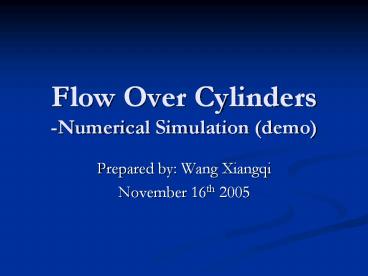Flow Over Cylinders -Numerical Simulation (demo) PowerPoint PPT Presentation
1 / 29
Title: Flow Over Cylinders -Numerical Simulation (demo)
1
Flow Over Cylinders-Numerical Simulation (demo)
- Prepared by Wang Xiangqi
- November 16th 2005
2
Introduction
- Relative motion between an object and a fluid is
common occurrence obstacles disturb the flow and
create particular shapes in their wakes. - The shape of the obstacle plays an important
role. - To understand this phenomena, studies are done on
a simple case a two-dimensional flow past a
circular/square cylinder for various Reynolds
number.
3
Background Knowledge
- Reltlt1
- Relt4
- 4ltRelt40
- 40ltRelt400 (Von Karmann vortex street)
4
Governing Equations
- Laminar
- Continuity
- Momentum
- Energy
- Turbulent model (k-e)
- k
- e
5
Physical Models
- Cylinder wall
- Upper and lower sides periodic
- Left side velocity inlet
- Right side Pressure outlet
- P Monitored point
Upper side
Inlet
P (0.06,0.06)
Outlet
Cylinder
Lower sides
- Inlet velocity inlet, UReµ/?D, T298.15 K
- Outlet P0 (atomistic pressure)
- Periodic walls ?P0 (zero pressure gradient)
- Cylinder T473.15 K
BCs
6
Typical Grid Structure
- Meshes
- The central square with a side length of six
times the radius of the cylinder was used to
facilitate meshing - Boundary layer with 10 rows was used at the
cylinder walls - Total meshes Circular (31,400) Square (34,600).
7
Numerical Procedure
- Obtain the steady solution
- Kelvin-Helmoltz perturbation (10U) for a while
(10s) if the Reynolds number is too low to active
the instability of flow - (Numerical errors also can, but need a long time)
- Compute the unsteady solution then.
- Criteria
- Steady solution convergence of average velocity
of monitored point - Unsteady solution 1e-4 for all variables except
1e-6 for energy time step size 1s
8
Temperature and Pressure Patterns (Re1)
Circular
Square
- At Re1, the flow is symmetrical upstream and
downstream. - Thermal dissipation
- For square cylinder, the thickness of thermal
layer is higher - For square cylinder, the pressure pattern is
elongated horizontally - Global pattern is similar for both cylinders.
9
Temperature and Pressure Patterns (Re100,
t1200s)
Circular
Square
- At Re100, phenomena of instability
- Convection is important
- Von Karmann vortex streets dominate
- The solution is unsteady and complicated
- Square cylinder eddies are stronger and show
larger amplitudes
10
Temperature and Pressure Patterns (Re1000)
Circular
Square
- At Re1000, turbulent flow
- The thermal layer is confined near the cylinder
- Boundary layer separation
- Von Karmann vortex street disappears
11
Velocity Patterns
Circular
Re1000
Re100 (t1200s)
Re1
Square
12
Vector Distribution (Circular, Re1)
13
Vector Distribution (Circular, Re100)
14
Vector Distribution (Circular, Re1000)
15
Vector Distribution (Square, Re1)
16
Vector Distribution (Square, Re100)
17
Vector Distribution (Square, Re1000)
18
Streamlines (Circular, Re1)
19
Streamlines (Circular, Re100)
20
Streamlines (Circular, Re1000)
21
Streamlines (Square, Re1)
22
Streamlines (Square, Re100)
23
Streamlines (Square, Re1000)
24
Occurrence of Instability (Re100)
Circular
Square
25
Occurrence of Instability (Re100)
- Circular cylinder
- Unsteady calculation from steady solution.
- Instability occurs due to the perturbation of
numerical errors (?) - Square cylinder
- Steady solution cannot be achieved (maybe the
mesh is not fine enough for square case to catch
the boundary layer?) - Unsteady solution from zero-value field (t0)
- Instability occurs at around t200s and results
in von Karmann vortex street. - As compared to circular cylinder, the amplitude
of square cylinder is larger.
26
Vector Distribution
Re100, t1000s
Line-6
Line-1
Line-2
Line-5
Line-3
Line-4
27
Nu Distribution Along the Wall
Re1
Re100
Re1000
Unsteady (t1200s)
28
Pressure Coefficient Along the Wall
Re1
Re100
Re1000
Unsteady (t1200s)
29
Effect of Strouhal Number
Monitored position (0.06,0.06), nStU/D
Re St (Exp.) T (s) n (mHz) n (mHz) f (mHz)
60 Cir. 0.137 82.54 12.01 12.11 12.11 0.90
60 Sq. 95.64 10.46 10.46
70 Cir. 0.148 66.45 15.13 15.05 15.05 0.56
70 Sq. 77.76 12.86 12.86
80 Cir. 0.155 55.33 18.11 18.07 18.07 0.21
80 Sq. 65.17 15.34 15.34
90 Cir. 0.16 47.70 21.03 20.96 20.96 0.34
90 Sq. 55.91 17.89 17.89
100 Cir. 0.166 41.61 24.24 24.03 24.03 0.89
100 Sq. 49.26 20.30 20.30
30
Conclusion
- The difference flow patterns depending on
Reynolds number are observed - The most important results is the visualisation
of the hydrodynamic instability called Strouhal
Instability or Von Karmann Vortex Street - The results are in good agreement with the
experimental values - The instability can be explained
- Mathematically, by the theory of the instability
- Physically, by the boundary layer separation.

